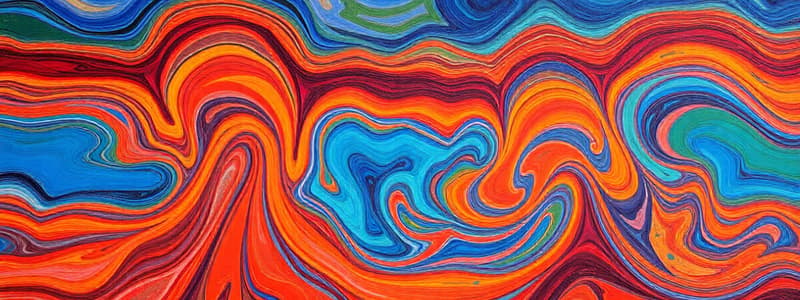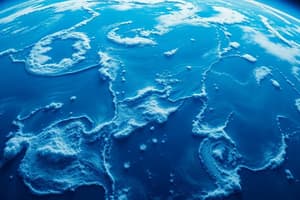Podcast
Questions and Answers
Match the following oceanic phenomena with their descriptions:
Match the following oceanic phenomena with their descriptions:
acoustical tomography = A technique for studying ocean structure using low-frequency sound Antarctic Bottom Water = The densest ocean water formed in Antarctica Antarctic Circumpolar Current = The largest ocean current that flows permanently eastward caballing = Mixing water masses of identical densities resulting in denser mixture
Match the following oceanic processes with their effects:
Match the following oceanic processes with their effects:
coastal upwelling = Upwelling induced by wind near a coast contour current = Dense bottom current flowing around seabed projections convergence zone = Boundary where waters of different densities meet countercurrent = Surface current flowing opposite to an adjacent current
Match the following terms related to water circulation with their definitions:
Match the following terms related to water circulation with their definitions:
current = Mass flow of water, typically horizontal downwelling = Vertical movement of surface water downward eastern boundary current = Weak, cold current at the eastern boundary of an ocean Eddy = Circular movement of water near current obstructions
Match the following models of oceanic dynamics with their characteristics:
Match the following models of oceanic dynamics with their characteristics:
Match the following terms with their associated effects on marine ecosystems:
Match the following terms with their associated effects on marine ecosystems:
Match the following currents with their main characteristics:
Match the following currents with their main characteristics:
Match the following oceanographic terms with their explanations:
Match the following oceanographic terms with their explanations:
Match the following processes with their influences on climate patterns:
Match the following processes with their influences on climate patterns:
Match the following terms with their definitions:
Match the following terms with their definitions:
Match the following oceanic processes with their descriptions:
Match the following oceanic processes with their descriptions:
Match the following currents with their characteristics:
Match the following currents with their characteristics:
Match the following descriptions with the correct terms:
Match the following descriptions with the correct terms:
Match the following currents to their direction of flow:
Match the following currents to their direction of flow:
Match these phenomena with their effects:
Match these phenomena with their effects:
Match the following events with their timing or occurrence:
Match the following events with their timing or occurrence:
Match the following types of circulation with their descriptions:
Match the following types of circulation with their descriptions:
Flashcards are hidden until you start studying
Study Notes
El Niño and La Niña
- El Niño is a warm current that occurs off the coast of western South America, caused by a break down in trade wind circulation.
- La Niña is an occurrence in which the tropical Pacific atmospheric and oceanic circulation strengthens and the water temperature in the eastern South Pacific drops below average.
- El Niño and La Niña are part of a complex system called ENSO (El Niño-Southern Oscillation).
Ocean Currents
- Ocean currents are responsible for the transfer of heat, salt, and nutrients throughout the globe
- Surface Currents: The horizontal flow of water at the ocean's surface.
- Undercurrent: A current that flows beneath a surface current, usually in the opposite direction.
- Transverse Current: East-to-west or west-to-east current that links eastern and western boundary currents.
- Eastern Boundary Current: A weak, cold, diffuse, slow-moving current at the eastern boundary of an ocean.
- Western Boundary Current: A strong, warm, narrow, fast-moving current at the western boundary of an ocean.
- Gyre: A circular current of mid-latitude currents around the periphery of an ocean basin.
- Geostrophic Gyre: A circular current in balance of the Coriolis effect and the pressure gradient.
- Global Ocean Conveyor Belt: A simplified outline of the 3D global circuit that ocean currents follow as they transport heat around the globe.
- Antarctic Circumpolar Current (West Wind Drift): The largest ocean current, driven by powerful westerly winds north of Antarctica.
Other important ocean terms
- Upwelling: The movement of deep, cold, nutrient-rich water to the surface.
- Equatorial Upwelling: Occurs on either side of the equator as water moves westward and is deflected slightly poleward, replaced by deep water.
- Coastal Upwelling: Occurs adjacent to a coast, usually induced by wind.
- Downwelling: The movement of surface water vertically downward.
- Langmuir Circulation: Shallow, wind-driven circulation of water in horizontal, spiral bands.
- Ekman Spiral: A theoretical model of the effect of wind blowing over the ocean. The surface layer drifts at an angle to the wind due to the Coriolis effect.
- Ekman Transport: The net water transport, the sum of layer movement due to the Ekman spiral.
- Convergence Zone: The line along which waters of different density converge.
- Countercurrent: A surface current flowing in the opposite direction from an adjacent surface current.
- Eddy: A circular movement of water usually formed when currents pass obstructions or between two adjacent currents flowing in opposite directions.
Properties of Water
- Temperature-Salinity (T-S) Diagram: A graph showing the relationship between temperature and salinity with depth.
- Thermohaline Circulation: Water circulation produced by differences in temperature and/or salinity.
Ocean Processes
- Caballing: Mixing of two water masses of identical densities, but different temperatures and salinities, resulting in a denser mixture.
- Contour Current: A bottom current flowing around (rather than over) seabed projections.
Notable Water Masses
- North Atlantic Deep Water: Cold, dense water formed in the Arctic that flows onto the floor of the North Atlantic.
- Antarctic Bottom Water: The densest ocean water, formed primarily in Antarctica's Weddell Sea.
Oceanographic Techniques
- Acoustical Tomography: A technique for studying ocean structure that uses low-frequency sound pulses to sense differences in water temperature, salinity, and movement.
Units of Measurement
- Sverdrup (sv): A unit of volume transport equal to 1 million cubic meters of water flowing past a fixed point each second.
Studying That Suits You
Use AI to generate personalized quizzes and flashcards to suit your learning preferences.




